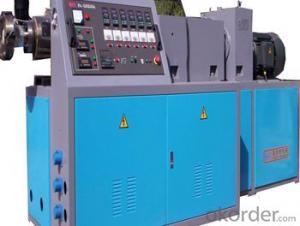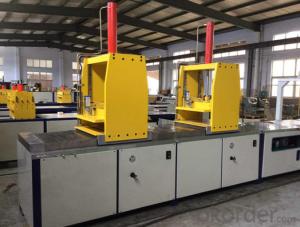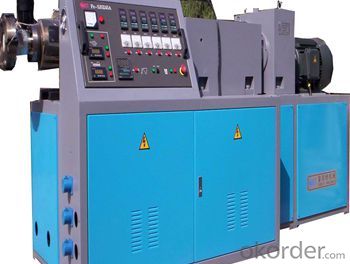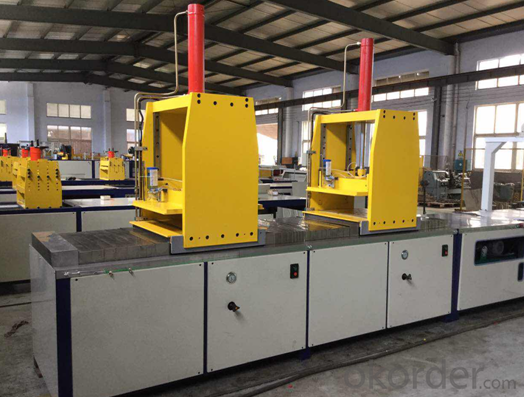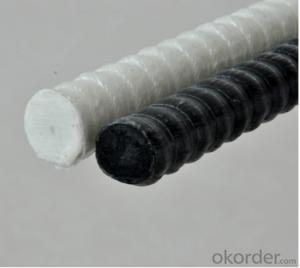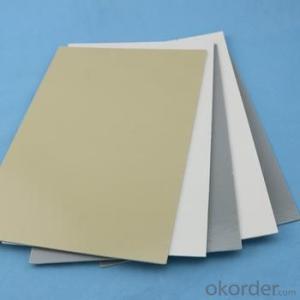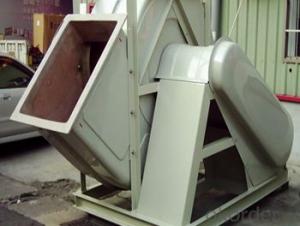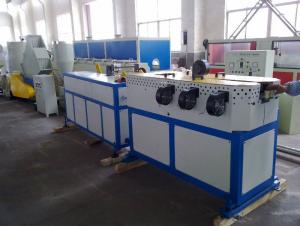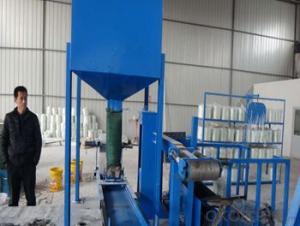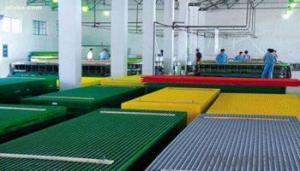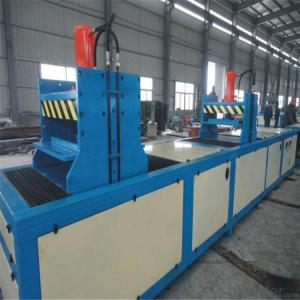FRP Pultrusion Profiles - Anti-Flammable FRP Pultruded Gratings with Best Quality
- Loading Port:
- Tianjin
- Payment Terms:
- TT OR LC
- Min Order Qty:
- 4000 m.t.
- Supply Capability:
- 100000 m.t./month
OKorder Service Pledge
OKorder Financial Service
You Might Also Like
Specification
PRODUCT DESCRIPTION
Pultruded grating is made by a particular assembly process, which using “I” shape as its main load-bearing and special rod to go through the bearing bar. Pultruded grating include the standard grating and the custom grating, the custom grating can be designed to meet customer’s requirement or special using condition by changing the shape, size and space of the bearing bars, the surface can be covered with lozenge panel, grit panel, or added the anti-slippery sand directly.
FRP pultruded grating has the most characteristics of molded grating, but it has its distinct advantages, it has very high fiberglass content in the loading direction, so it has very high load capability, it has more superiority when used at wide span, so that the basic support will be decreased and the project cost will be reduced accordingly.
SPECIFICATION
The standard space between two crossbars is 6 inch or 12 inch.
Thickness (mm) | Bar width (mm) | Open space (mm) | Open rate (%) | Approx weight (kg/m |
25.4 | 15.2 | 22.8 | 60 | 13.2 |
25.4 | 15.2 | 15.2 | 50 | 15.9 |
25.4 | 15.2 | 10.1 | 40 | 18.5 |
25.4 | 40 | 10.8 | 21 | 14.5 |
38.1 | 15.2 | 22.8 | 60 | 15.8 |
38.1 | 15.2 | 15.2 | 50 | 19.1 |
38.1 | 15.2 | 10.1 | 40 | 22.4 |
50.8 | 25.4 | 25.4 | 50 | 16.6 |
50.8 | 25.4 | 12.7 | 33 | 21.1 |
CHOICE FOR PULTRUDED GRATING
Resin: GP resin, ISO resin, VE resin, Phenol resin
Color choice: Yellow, gray, green, custom color
Surface choice: Groove surface, grit surface, lozenge cover surface
FEATURES
a. Anti-corrosion and anti-rust
b. Light weight and high strength
c. Anti-flammable
d. Anti- fatigue
e. Safe and anti-slippery
f. Anti-ageing
g. Easy of maintenance
h. Excellent electromagnetism property
i. Good economic benefit
FIELDS SERVED
Sewage treatment,
water supply and drainage,
chemical industry,
oil industry,
power engineering,
pulp and paper,
construction engineering,
spinning, marine engineering.
APPLICATION
Operation terrace,
stair walkway,
ground floor,
trench cover,
sidewalk,
foot bridge.
COMPANT DESCRIPTION
CNBM International Corporation is one subsidiary of CNBM, we focus on offering good-quality products,professional service and complete solution to our customers. Strong delivery capacity, advanced technology& management, strong financing capability and excellent after-sale service are our advantages in sharing international market.
FAQ
Q1.What's your sample policy?
A:We can supply the sample if we have ready parts in stock, but the customers have to pay the courier cost.
Q2.Can you produce according to the samples?
A: Yes, we can produce or modify the products according to your request.
Q3.How do you deliver the goods to my country?
A:We can provide international express, such as DHL, EMS, UPS, FedEx, etc. We select air freight and sea freight upon your requests. Quotations if without mentioning the shipping costs are shipping fee excluded.
Q4.How much does it cost to ship to my country?
A:When you goanna to place an order, please contact us, because different country has different freight.
Q5.How to get the catalogue?
A:please contact us and tell us what you are looking for.
PICTURES
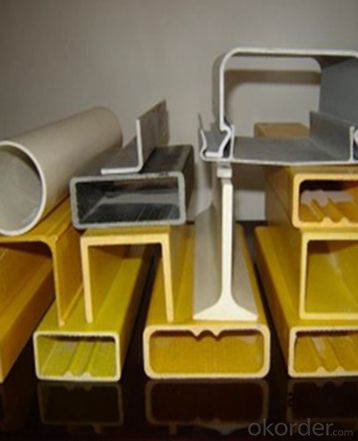

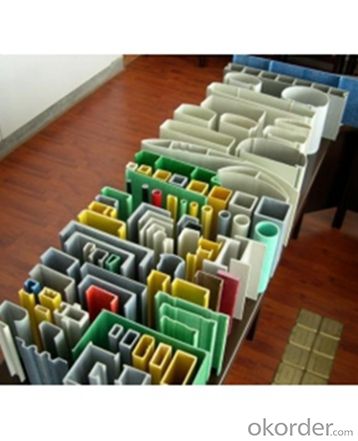
- Q: What are the typical applications of FRP pultrusion profiles?
- FRP (Fiber Reinforced Polymer) pultrusion profiles have a wide range of applications due to their unique properties. Some of the typical applications of FRP pultrusion profiles include: 1. Construction and Infrastructure: FRP profiles are used for various structural elements in buildings, bridges, and other infrastructure projects. They are commonly used for beams, columns, decks, and reinforcement due to their high strength-to-weight ratio, corrosion resistance, and durability. 2. Industrial and Chemical Processing: FRP profiles are extensively used in the industrial sector for applications such as platforms, walkways, ladders, and handrails. They offer excellent resistance to chemicals, heat, and corrosion, making them suitable for harsh environments. 3. Electrical and Telecommunication: FRP profiles are utilized for cable trays, ladder racks, and support structures in electrical and telecommunication systems. They provide electrical insulation and are non-conductive, ensuring safety and reliability in these applications. 4. Transportation: FRP profiles find applications in the transportation industry, particularly in the manufacturing of lightweight components for vehicles, including buses, trains, and trucks. They help reduce weight, improve fuel efficiency, and enhance the overall performance of these vehicles. 5. Marine and Offshore: FRP pultrusion profiles are well-suited for marine and offshore applications due to their resistance to saltwater, UV radiation, and harsh environmental conditions. They are used for boat hulls, piers, dock fenders, and other offshore structures. 6. Recreation and Sports: FRP profiles are employed in the production of various recreational equipment such as ladders, slides, playground equipment, and sports accessories. Their high strength, durability, and resistance to weather elements make them ideal for these applications. 7. Water Treatment and Wastewater Management: FRP profiles are widely used in water treatment plants, sewage systems, and wastewater management facilities. They are used for grating, handrails, ladders, and other structural components due to their resistance to chemicals and corrosion. Overall, the versatility, strength, corrosion resistance, and lightweight nature of FRP pultrusion profiles make them suitable for a diverse range of applications in different industries.
- Q: Can FRP pultrusion profiles be used in the automotive industry?
- Yes, FRP (Fiber Reinforced Plastic) pultrusion profiles can definitely be used in the automotive industry. FRP pultrusion profiles offer several advantages that make them suitable for automotive applications. Firstly, FRP pultrusion profiles are lightweight, which is a crucial factor in the automotive industry as it helps in improving fuel efficiency and reducing overall vehicle weight. Lighter vehicles have lower energy consumption and emissions, making them more environmentally friendly. Secondly, FRP pultrusion profiles have excellent strength-to-weight ratio. This means they can provide high strength and stiffness while being lightweight. This property makes them ideal for structural components in automobiles, such as chassis, body panels, and support structures. Furthermore, FRP pultrusion profiles are highly corrosion-resistant, which is a significant advantage in automotive applications. Vehicles are often exposed to harsh environmental conditions, including moisture, salt, and chemicals. The corrosion resistance of FRP helps in ensuring the longevity and durability of automotive components, even in challenging environments. Additionally, FRP pultrusion profiles have good impact resistance, which is crucial for automotive safety. They can absorb and dissipate energy during impacts, reducing the risk of injury in case of accidents. Moreover, FRP pultrusion profiles can be customized and engineered to meet specific design requirements, allowing for versatility in automotive applications. They can be designed to have specific mechanical properties, shapes, and sizes, making them suitable for various automotive components. Overall, the lightweight, high strength, corrosion resistance, impact resistance, and customization options make FRP pultrusion profiles an excellent choice for the automotive industry. They offer numerous benefits, including improved fuel efficiency, enhanced safety, and prolonged component life, making them a viable alternative to traditional materials in automotive applications.
- Q: How do FRP pultrusion profiles handle cyclic loading?
- FRP pultrusion profiles are known for their excellent performance under cyclic loading conditions. The unique combination of materials and manufacturing process used in pultrusion makes these profiles highly resistant to fatigue and cyclic loading effects. One key factor that contributes to the superior performance of FRP pultrusion profiles under cyclic loading is their inherent high strength-to-weight ratio. These profiles are made using continuous fibers, typically fiberglass, which are impregnated with a resin matrix. This results in a lightweight yet strong material that can handle repeated loading without experiencing significant degradation or fatigue. Additionally, the pultrusion process allows for precise control over the fiber orientation and resin distribution within the profile. This results in a uniform and consistent material composition throughout the entire length of the profile. As a result, FRP pultrusion profiles exhibit excellent load distribution characteristics, minimizing stress concentrations and preventing localized failure under cyclic loading conditions. Furthermore, the corrosion resistance of FRP pultrusion profiles plays a crucial role in their ability to handle cyclic loading. Unlike traditional materials such as steel, FRP profiles do not suffer from corrosion-related issues, such as rust or pitting. This corrosion resistance ensures that the profiles maintain their structural integrity even when subjected to cyclic loading over extended periods of time. Overall, FRP pultrusion profiles are specifically designed and manufactured to withstand cyclic loading conditions. Their high strength-to-weight ratio, uniform material composition, and corrosion resistance make them ideal for applications where cyclic loading is a significant factor. Whether it's in structural reinforcements, bridges, sporting equipment, or various industrial applications, FRP pultrusion profiles have proven to be reliable and durable under cyclic loading.
- Q: Are FRP pultrusion profiles resistant to hail or impact damage?
- Yes, FRP (Fiber Reinforced Polymer) pultrusion profiles are highly resistant to hail or impact damage. The combination of reinforcing fibers, such as carbon or glass, and a polymer resin matrix provides exceptional strength and durability to FRP pultrusions. These profiles have superior impact resistance compared to other materials like wood, steel, or aluminum. FRP pultrusion profiles are designed to withstand harsh environmental conditions, including hailstorms. The composite nature of FRP allows it to absorb and distribute impact energy, preventing the formation of cracks or fractures. This makes them an ideal choice for applications that require resistance to hail or impact damage, such as building facades, bridges, handrails, or utility poles. Furthermore, FRP pultrusion profiles have a high strength-to-weight ratio, meaning they can withstand heavy impacts without compromising their structural integrity. They are also non-corrosive, which makes them immune to rust or degradation caused by hail or impact. In summary, FRP pultrusion profiles are highly resistant to hail or impact damage due to their composite construction and excellent strength-to-weight ratio. They provide a reliable and long-lasting solution for applications that require durability and resistance to harsh environmental conditions.
- Q: Can FRP pultrusion profiles be used in the construction of conveyor systems?
- FRP pultrusion profiles are highly effective in the construction of conveyor systems. They offer numerous advantages that make them suitable for this purpose. To begin with, these profiles are both lightweight and strong, making them ideal for constructing conveyor systems. Their high strength-to-weight ratio allows for easy installation and maintenance, reducing the overall weight of the system while maintaining structural integrity. This is particularly beneficial when designing and building long-span conveyor systems. Additionally, FRP pultrusion profiles are highly resistant to corrosion. Unlike traditional materials such as steel or aluminum, they do not rust or deteriorate when exposed to chemicals or moisture. This resistance makes them particularly suitable for conveyor systems that may be subjected to harsh environments or corrosive substances, such as those found in the mining or chemical industries. Another advantage of FRP pultrusion profiles is their excellent electrical insulation properties. They do not conduct electricity, which is essential in conveyor systems where electrical components are present. This property ensures a higher level of safety and reduces the risk of electrical hazards. Furthermore, these profiles can be easily customized to meet specific design requirements. They can be manufactured in various shapes and sizes, providing flexibility in conveyor system design. Additionally, they can incorporate features such as channels, slots, or reinforcements, which can be advantageous for mounting accessories or facilitating the movement of goods on the conveyor. Lastly, FRP pultrusion profiles are highly durable and have a long service life. They are resistant to UV degradation and do not require frequent maintenance or painting, resulting in reduced lifecycle costs compared to traditional materials. This durability makes them a cost-effective choice for constructing conveyor systems. In conclusion, FRP pultrusion profiles are an excellent option for constructing conveyor systems. Their lightweight nature, corrosion resistance, electrical insulation properties, customization options, and durability make them a reliable and efficient material for this application.
- Q: Are FRP pultrusion profiles suitable for the manufacturing of antenna masts?
- Yes, FRP pultrusion profiles are suitable for the manufacturing of antenna masts. FRP pultrusion profiles offer several advantages such as high strength-to-weight ratio, corrosion resistance, and excellent electrical insulation properties. These characteristics make them ideal for antenna mast construction, as they can withstand various environmental conditions and provide reliable support for antennas.
- Q: Are FRP pultrusion profiles resistant to acids?
- FRP pultrusion profiles, known as Fiber Reinforced Polymer pultrusion profiles, exhibit a notable resistance to acids. This corrosion resistance is a significant advantage that sets FRP apart from traditional materials like steel or wood. The composite materials employed in FRP pultrusion profiles display exceptional resistance to a broad spectrum of acids, including organic and inorganic varieties. The ability of FRP pultrusion profiles to resist corrosion can be attributed to the chemical composition of the composite materials. The reinforcing fibers, such as glass or carbon fibers, exhibit a high resistance to acid attacks. Furthermore, the polymer matrix used in FRP acts as a protective barrier, preventing acid penetration. It is important to acknowledge, however, that the resistance of FRP pultrusion profiles to acids may vary depending on the specific type of acid and its concentration. While FRP generally offers resistance against most acids, certain aggressive acids or highly concentrated solutions may cause some degradation over time. For optimal performance and durability, it is advisable to consult the manufacturer or supplier of FRP pultrusion profiles for precise information regarding their resistance to acids. They can provide valuable guidance on the suitability of FRP profiles for applications involving acids and recommend additional protective measures, such as coatings or liners, if necessary.
- Q: Can FRP pultrusion profiles be used in the transportation and logistics industry?
- Yes, FRP pultrusion profiles can be used in the transportation and logistics industry. These profiles offer a lightweight and high-strength alternative to traditional materials like steel or aluminum. They are resistant to corrosion, have excellent dimensional stability, and can be customized to meet specific design requirements. FRP pultrusion profiles are commonly used in applications such as truck bodies, trailers, shipping containers, and infrastructure for transportation and logistics purposes.
- Q: How do FRP pultrusion profiles withstand extreme temperatures?
- The unique properties of the materials used in the construction of FRP (Fiber Reinforced Polymer) pultrusion profiles allow them to withstand extreme temperatures. To begin with, FRP pultrusion profiles consist of reinforcing fibers, such as fiberglass or carbon fiber, combined with a polymer resin matrix. These fibers provide exceptional strength and rigidity, while the resin functions as a protective binder, holding the fibers together and offering heat resistance. The reinforcing fibers employed in FRP pultrusion profiles possess high melting points and are inherently non-combustible. As a result, they retain their structural integrity even in elevated temperatures. This quality prevents the profiles from melting, warping, or becoming brittle under extreme heat conditions. In addition, the polymer resin matrix used in FRP pultrusion profiles is meticulously selected to have a high glass transition temperature (Tg). The Tg represents the temperature at which the resin transitions from a rigid, glassy state to a more flexible, rubbery state. By utilizing a resin with a high Tg, FRP pultrusion profiles can endure extreme temperatures without compromising their mechanical properties. Moreover, the pultrusion manufacturing process itself contributes to the ability of FRP profiles to withstand extreme temperatures. During pultrusion, the reinforcing fibers are carefully saturated with the resin matrix and then pulled through a heated die. This process ensures an even distribution of the resin throughout the profile, enhancing its resistance to heat and temperature fluctuations. In conclusion, the combination of high-performance reinforcing fibers, a carefully selected resin matrix, and the pultrusion manufacturing process enables FRP pultrusion profiles to endure extreme temperatures, making them suitable for a wide range of applications in diverse industries.
- Q: Can FRP pultrusion profiles be used in mining applications?
- Yes, FRP pultrusion profiles can be used in mining applications. FRP (Fiber Reinforced Polymer) pultrusion profiles offer excellent strength-to-weight ratio, corrosion resistance, and durability, making them suitable for various mining applications such as support structures, ventilation systems, walkways, and equipment enclosures. Additionally, FRP profiles are non-conductive and non-magnetic, making them ideal for underground mining environments.
Send your message to us
FRP Pultrusion Profiles - Anti-Flammable FRP Pultruded Gratings with Best Quality
- Loading Port:
- Tianjin
- Payment Terms:
- TT OR LC
- Min Order Qty:
- 4000 m.t.
- Supply Capability:
- 100000 m.t./month
OKorder Service Pledge
OKorder Financial Service
Similar products
Hot products
Hot Searches
Related keywords
